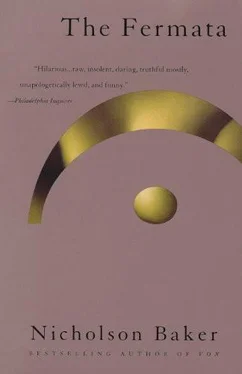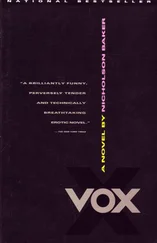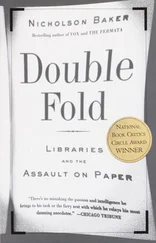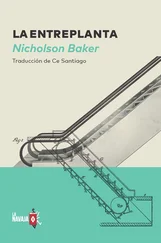Nicholson Baker - The Fermata
Здесь есть возможность читать онлайн «Nicholson Baker - The Fermata» весь текст электронной книги совершенно бесплатно (целиком полную версию без сокращений). В некоторых случаях можно слушать аудио, скачать через торрент в формате fb2 и присутствует краткое содержание. Год выпуска: 1996, Издательство: Vintage, Жанр: Современная проза, на английском языке. Описание произведения, (предисловие) а так же отзывы посетителей доступны на портале библиотеки ЛибКат.
- Название:The Fermata
- Автор:
- Издательство:Vintage
- Жанр:
- Год:1996
- ISBN:нет данных
- Рейтинг книги:4 / 5. Голосов: 1
-
Избранное:Добавить в избранное
- Отзывы:
-
Ваша оценка:
- 80
- 1
- 2
- 3
- 4
- 5
The Fermata: краткое содержание, описание и аннотация
Предлагаем к чтению аннотацию, описание, краткое содержание или предисловие (зависит от того, что написал сам автор книги «The Fermata»). Если вы не нашли необходимую информацию о книге — напишите в комментариях, мы постараемся отыскать её.
The Fermata — читать онлайн бесплатно полную книгу (весь текст) целиком
Ниже представлен текст книги, разбитый по страницам. Система сохранения места последней прочитанной страницы, позволяет с удобством читать онлайн бесплатно книгу «The Fermata», без необходимости каждый раз заново искать на чём Вы остановились. Поставьте закладку, и сможете в любой момент перейти на страницу, на которой закончили чтение.
Интервал:
Закладка:
I snipped all the thread from my hands and amassed a load’s worth of dirty clothes from the floor of my room (supplemented by several towels) and I started a large warm wash with the lid open and the interlock jammed. While the wash churned through its preliminaries, I chose a new needle, threaded it, and pushed it through the thus-far-unsewn callus at the base of my left hand’s middle finger. I put the spool in place on the nail and wrapped the loose end of the thread around the post of the washing machine. Now, as the spin cycle began, it pulled the thread through my callus, through a part of me, in winding it onto itself. The thread tugged through the hole in my skin surprisingly easily, faster and faster. My hand lay on the sill of the washer, face up. The heat of the friction began to hurt; when it became almost unbearable, and I was on the verge of closing my fist on the thread to snap it, the event, or non-event, happened. Everything stopped. I looked into the tub of the washing machine and was thrilled to be able to see and even touch that fiction of the physical sciences, centrifugal force. Without suffering harm, I could now reach in and hold clothes that were in the midst of spinning at six hundred r.p.m. I put my hand in the machine. The remaining blue water, immobilized in its turbulence and yet still wet to the touch, was especially beautiful. The world was again available for undressing. But I knew that if the thread that ran through my callus broke, time would resume. So I was unfortunately tethered to the washing machine.
Over a period of ten minutes I laboriously paid out the thread through my callus so that I could walk upstairs and out to the yard. A bird was out there, a robin, paused in the air, about three feet off the lawn — I touched its spread wings, though not hard enough to dislodge it from its pausal locus. I continued to unspool my callus-thread until I had reached the street. A woman was in a station wagon with her elbow on the door. I touched her shoulder with my hand, then reached into her blouse and went under her bra and felt her hot heavy ostrich egg of a breast. Her nipple was amazingly soft. Her hair was motionlessly wind-fluffed; the speedometer said thirty miles an hour. That soft unselfconscious nipple I touched (my very first after infancy, recall) was driving down the street at thirty miles an hour while I, caressing it at leisure, stood in place! When I had learned enough about the weight and highly advanced mobility of her entire Jamaica in my coarse and threaded hand (joggling it reminded me, to my surprise, of the variable heft of a Slinky toy as you let its arched length recoil back and forth from palm to palm), I went back to the sidewalk so that I wouldn’t be run over, and I yanked on the thread until it broke. I pulled it from the hole in my callus. The station wagon sighed promptly by — I saw a flash of the woman in profile, then the back of her car, her meaninglessly specific license plate, then her turn-signal light blinking, then she turned down Southland Street, gone. In the basement, my clothes took up with their spinning as if I were still standing at the washing machine looking in. Nobody in the cars that followed seemed to notice that I had just appeared next to a bushy spray of elm-stump suckers, out of nowhere.
My second successful drop-phase ended there, circa August 1969: it, like the time-transformer experiment that helped me into Miss Dobzhansky’s shirt, was apparently induplicable, depending on exactly those particular clothes and towels,those calluses, and that specific new packet of needles from the Needle Man. Tethering oneself to a clothes-washer was in any case a somewhat awkward way of forcing time into remission; although as I thought that period over on the beach towel in the yard I remembered none of the awkwardness — only how leapingly happy I had been for the rest of the day because I knew then, after all my false starts and failed attempts, that there really was more than one way to trip the universal clutch.
Now, out in the back yard, because I was so desperate to stop the calendar, I considered trying something like it again: sewing through my fingers and washing the very towel I lay on. But the fact was that my adult skin was much too thin. Typing does not make for heavy callusing. (As I type I can feel the raised pleasure-dots on the J and F keys of the typical keyboard, molded there to let you know that your fingers are properly stationed in the “home” position, with something close to discomfort, so tender are my fingertips.) Perhaps there was a way to trigger a Drop by pretending I was sick and going to Commonhealth, my HMO, and listing off lots of mysterious pains and moments of dizziness in the shower, so that the doctor would order some comprehensive blood work, and when the blood was sucked from my elbow and spun at six thousand r.p.m. in a bucket centrifuge in the lab to separate the yellow plasma from the red cells, that higher-speed self-centrifugation would re-create the conditions of the primordial washing machine, and I would, while the spin was in progress, be able to unclasp the Hispanic phlebotomises bra while she posed in the Fermata, expertly tapping into someone else’s vein. But I rejected the possibility, since even if a temporal hematocrit worked, it would be too unpredictable and impossible to control; I needed a way to switch time on and off quickly and easily.
But this notion of self-centrifugation did and does have a powerful appeal, and I sometimes have the distinct sense, as I hover in the middle of a page of this memoir, choosing which of my past Fermatas I will relate next, that in order to write my life properly I need the entire receptacle of my consciousness spun, as the ultracentrifuge’s rotor spins its vials of biological freight, fast enough to conquer diffusion and impose some artificial order. I need to dangle in a severe vacuum from a one-tenth-inch-thick length of piano wire (like the rotor in the old Spinco Model E ultracentrifuge, developed in the fifties by Edward G. Pickels and his colleagues and still in use in a number of grant-depleted research programs in protein chemistry), while a xenon lamp flashes some unforgiving wavelength over my memory sample, rotating sixty times faster than the washing machine in my basement did — I want all of the semi-remembered images of half-dressed women, all these fragments of my voyeuristic history, that still remain in messy colloidal suspension to fly around at the speed of insight until they are compelled to file themselves away once and for all into neat radial gradients of macromolecular uniformity, like layered cocktails or fancy multicolored creations in Jell-O. I happen to know, from a three-week assignment in the research department of Kilmer Pharmaceuticals (for better or worse, an alert temp can pick up lots of stray knowledge), that biochemists routinely use the centrifuge (especially the low-end tabletop Beckman model called the Microfuge) to spin down, or “pellet,” lengths of DNA in order to purify or clean them. And everything in the mind — that final triumph of protein chemistry — is likewise in helpless motion, afloat, diffuse, impure, unwilling to commit to precipitation: only an artificially induced pensive force of hundreds of thousands of gravities can spin down some intelligible fraction of one’s true past self, one’s frustratingly polydisperse personality, into a pellet of print.
One evening after work very recently, needing to rev myself up to continue writing some section of this very document, I snapped time off and went for an indoor walk around the research buildings of Mass General, looking for ultracentrifuges and for the breathtaking women post-docs who use them. I again vaguely envisioned centrifuging some of my own cells, this time for the pure ideational rush of it: I could devote a whole Pause to placing small samples of my blood (or possibly sperm, though that seemed a needlessly cruel thing to do to my sperm) in every Sorvall and Beckman and Hitachi ultracentrifuge in Boston and Cambridge and setting them all on top speed. I would be anemic and listless by the end, but I wouldn’t care, because I would know that at that second my own perky little cells were being crushed into alternative world orders of protoplasm by exotic megagravities in expensive vacuums in every high-powered NIH-funded research program in the area, and that trickster knowledge would power me upward into raptures of self-knowledge and self-abandonment. But I didn’t actually do it, because I would then have had to clean all the bloody test tubes after their runs were completed, since I wouldn’t want to leave something as unsettling as provenanceless yellow plasma around for researchers to discover. Fear is my least favorite emotion; I want to be responsible for creating as little of it as possible. I did look at a fair number of ultracentrifuges, however, and what I noticed was that the big floor-model machines, the ones built in Palo Alto by Beckman Instruments, bore a surprisingly strong resemblance to clothes-washers. They were a little wider, and they were blue (which should be a standard color for washing machines but perplexingly is not), and a close look at the control panel revealed, in addition to familiar words like SPEED, TIME, and TEMP, the less laundry-relevant terms VACUUM and ROTOR — but they still had an oval opening in the top that you closed after loading with a simple latch, and their direct-drive motor (I learned this from flipping through a textbook in one of the lab’s libraries) operated on exactly the same induction principal as a Maytag’s. The huge difference between these two consumer durables (and I think one of the best things about centrifuge as a noun is the ghost of the word huge it safely contains) was that the Beckman machine could turn a rotor, fitted with eight or even twelve little cuvettes containing some biohazard or other, at sixty thousand r.p.m. In other words, it could dependably spin, without flying apart, or overheating, or making disturbing noises (I noticed that it was quieter than a washing machine), at a rate of over one thousand revolutions per second .
Читать дальшеИнтервал:
Закладка:
Похожие книги на «The Fermata»
Представляем Вашему вниманию похожие книги на «The Fermata» списком для выбора. Мы отобрали схожую по названию и смыслу литературу в надежде предоставить читателям больше вариантов отыскать новые, интересные, ещё непрочитанные произведения.
Обсуждение, отзывы о книге «The Fermata» и просто собственные мнения читателей. Оставьте ваши комментарии, напишите, что Вы думаете о произведении, его смысле или главных героях. Укажите что конкретно понравилось, а что нет, и почему Вы так считаете.












